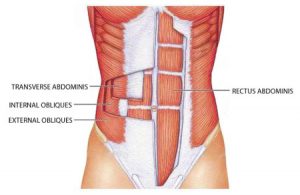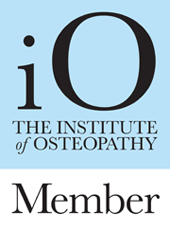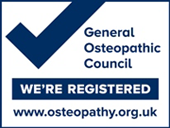Osteopathy & abdominal muscles
Introduction
Are you, like many, on a quest to find the best exercise routine for developing flatter and tighter ‘abs’?
Every year we see the introduction of new exercises, fitness classes, products and gadgets on the market claiming to sculpt and strengthen the abdominal muscles like nothing else.
Some of these may offer a new approach to working the abdominal muscles but in truth, many are ineffective and can increase the risk of injury.
It is therefore important to have a good understanding of the abdominal muscles, including their location, function and how best to exercise them with minimal risk of injury.
Anatomy & function
1. Rectus Abdominis
The most prominent abdominal muscle is the rectus abdominis. It is the long, flat muscle that extends vertically between the pubis and the 5th – 7th ribs.
A strong tendinous sheath called the linea alba (white line), divides the rectus abdominis down the middle and three horizontal tendinous sheaths give the muscle its familiar washboard appearance very toned people.
The role of the rectus abdominis is to facilitate flexion of the spinal column, narrowing the space between the pelvis and the ribs. It also assists with side-bending movements and helps to stabilise the trunk during movements involving the extremities and head.
2. External Obliques
The external obliques are a pair of muscles located on each side of the rectus abdominis. The muscle fibers of the external obliques run diagonally downward and inward from the lower ribs to the pelvis, in a ‘v’ shape.
They originate at the 5th to 12th ribs and attach into the iliac crests of the hips, the inguinal ligament and the linea alba of the rectus abdominis.
The external oblique muscles facilitate flexion of the spine, rotation of the torso, side-bending and compression of the abdomen.
3. Internal Obliques
The internal obliques are another pair of deep muscles, situated just below the external obliques. The internal and external obliques are at right angles to each other.
The internal obliques attach from the lower three ribs to the linea alba, from the inguinal ligament to the iliac crest and into the erector spinae muscles of the lower back.
The internal obliques share the same functions as the external obliques.
Due to their unique alignment at right angles to each other, the internal and external obliques facilitate rotation in opposition to each other. When the trunk rotates left, the external obliques contract on the right. When the trunk rotates to the right, the external oblique fibers activate on the left.
4. Transversus Abdominis
The transversus abdominis forms the deepest layer of abdominal muscles, wrapping around the torso from front to back and from the ribs to the pelvis. The muscle fibers of the transversus abdominis run horizontally, similar to a corset or a weight belt.
This muscle does not assist with the movement of the spine or the pelvis, but instead with respiration and breathing. It helps to facilitate forceful expiration of air from the lungs, stabilises the spine and helps to compress the internal organs.
5. Hip Flexors
The function of this collection of muscles is to bring the legs and trunk together in a flexion movement. The hip flexors are not technically abdominal muscles, but they do facilitate movements during several ab exercises. The muscles included within the hip flexor group are: Psoas Major, Iliacus, Rectus Femoris, Pectineus and Sartorius.
The majority of abdominal exercises in reality work the hip flexors more than the abdominals. The hip flexors are strong, powerful muscles that often overtake the abdominal muscles when performing some variations of abdominal exercises. In order to isolate the abdominals, it is necessary to minimise the involvement of the hip flexors and to maximise the contraction of the abdominals.
One example of an abdominal exercise that actually focuses more on the hip flexors is a full sit-up, especially when the feet are held down. This movement primarily involves the hip flexors and may cause the lower back to arch, increasing the risk of low back pain, particularly if you have weak abdominal muscles. It is therefore inadvisable for complete beginners to perform full sit-ups.
Contact us if you have any questions & good luck in your six pack quest! 01525 290615



